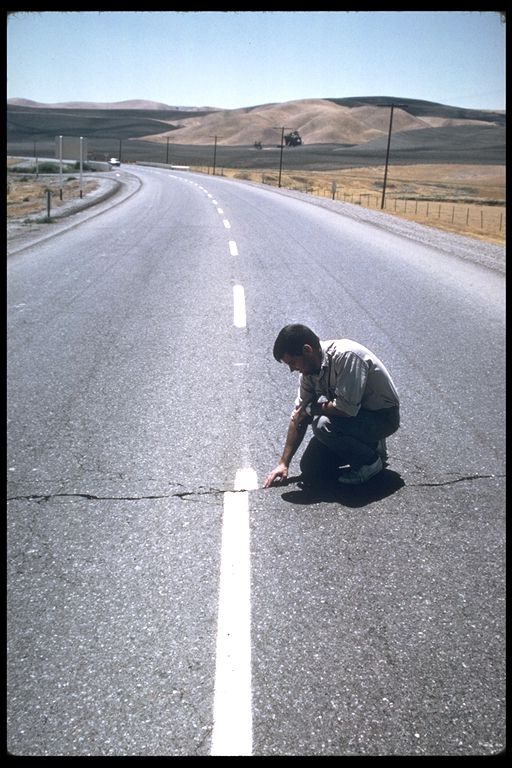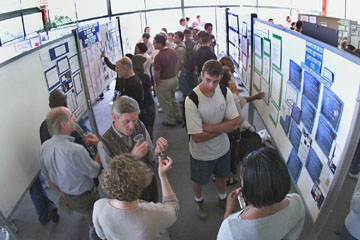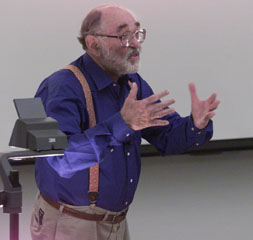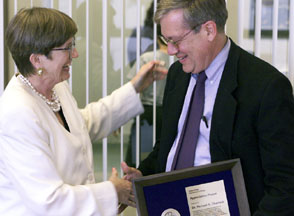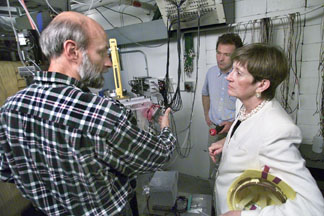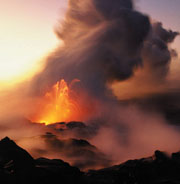
| Tiny Parkfield Quakes Help Lab Scientists Measure Slipping Fault |
A Look Back at a Scientific Voyage |
- Posters Show off Student Work
- Research Probe Raises Scientific Integrity Issues
- Washington Report
- Martha Krebs Recognizes Lab Scientists, Management
- Berkeley Lab Licenses Bio Probe to Start-Up Firm
- Fly Holds Clues to Human Genomes
- Drilling Into a Plume of Fire
- Lab Volunteers Bring Energy Efficiency to Community Effort
- Millennium Laughs
- Bulletin Board
- Lab Life
- Calendar of Events
- Flea Market
Tiny Parkfield Quakes Help Lab Scientists Measure Slipping Fault
By Paul Preuss
The little town of Parkfield, population 34, sits halfway between San Francisco and Los Angeles in dry ranching country, about as far from a population center as you can get on the San Andreas Fault. Which is lucky, because modern scientific measurements and the historical record both indicate that Parkfield has the highest likelihood anywhere in the country of experiencing an earthquake of magnitude 6 or higher.Now Robert Nadeau and Thomas McEvilly of the Earth Sciences Division report that clusters of identically repeating tiny earthquakes near Parkfield can be timed to reveal the rate at which the great North American and Pacific tectonic plates are grinding past each other deep within the earth. The timing of these "tickers" may provide a new way to monitor the buildup of deep fault strain that is associated with large earthquakes.
The two geophysicists reported their findings, based on new analyses of high-resolution data, in the July 30 issue of Science magazine. Because magnitude 6 shocks have occurred near Parkfield at regular intervals in the past, the area has been a center of seismic study by the U.S. Geological Survey and other institutions since 1987.
"Between 1857 and 1966, quakes of magnitude 6 occurred at Parkfield an average of every 22 years. Despite expectations, there hasn't been another one since 1966," Nadeau says. "However, a build-up of activity started in October of 1992 and persisted through 1994, including four events ranging in magnitude from 4.2 to 5."
|
"We have since found a highly organized relationship between the intervals of individual microearthquakes in clusters, the occurrence of the larger events, and changes in fault slip on the surface," Nadeau says.
The 1992-94 events and the magnitude 6 earthquakes of the previous century all started within the same eight-kilometer strip of the fault. They resulted from sudden releases of strain built up between the rocks of the Pacific Plate to the west, which is gradually but intermittently sliding northward, and the North American plate to the east.
Historically, the larger the earthquake, the more widespread the slippage. Slippage doesn't start at the surface epicenter, however, but at the quake's hypocenter, which in the Parkfield region is typically 8 to 10 kilometers beneath the surface. Hypocenters can be pinpointed in three dimensions to within a few meters by comparing the arrival times of seismic waves as they come in at a different seismometers.
At Parkfield some seismometers are placed at the bottom of boreholes 200 to 300 meters deep. "There's a lot less noise in the data than with surface seismometers, so we can detect many more quakes and smaller quakes," Nadeau says. "We can also measure earthquake vibration across a wide range of frequencies, which allows us to see much more detail in the behavior of the quakes."
Over time, some two-thirds of all the seismic activity in the Parkfield region has been organized into about 300 localized clusters of microearthquakes. "We identified 160 sequences within these clusters, each with three or more repeating quakes." In the model developed by Nadeau and McEvilly, these clusters represent small, strongly locked regions where strain repeatedly builds up and is released.
"Then we looked at how the recurrence of intervals between quakes in each sequence changed over time," Nadeau says. He and McEvilly hypothesized that shorter and shorter recurrence intervals indicated accelerating fault slippage and that when intervals got longer, slippage was slowing down.
They also found good agreement between the seismic data and direct measurements of slippage on the surface, made by creepmeters looking across the fault. Where large parts of the fault are locked, as in the region where the magnitude 6 quakes were centered, an increase in the repetition rate in specific clusters means that the strain load is building faster. When it reaches a critical level, a swarm of medium-sized quakes may dissipate the load, or a single larger event may do so.
By looking at an 11-year collection of data, Nadeau and McEvilly were able to track a zone of accelerated slippage as it moved along the fault from northwest to southeast. When this traveling zone of strain reached the hypocenters of the past magnitude 6 quakes in 1992, it apparently triggered the subsequent magnitude 4-plus events.
Nadeau and McEvilly suggest that these events may have occurred in response to the "pulse" of increased slip rate deep in the fault; the beginning of the pulse was detected prior to the events, but once it passed through the region, the larger quakes stopped.
The persistent, distinctive signatures of individual clusters of microearthquakes and the changes in intervals between them provide a new means of correlating measurements taken near the surface of the San Andreas Fault with slip rates from two to 10 kilometers below the surface. Brown University geophysicist Terry Tullis, in an article in the July 30 issue of Science, compares Nadeau and McEvilly's method to "a creepmeter installed across the fault at a depth of 10 km," showing "that if we look at the fault zone carefully enough we can learn things that we never expected to find."
While Nadeau found a way to use data on the recurrence of micro-earthquake clusters to determine slip rates at depth in the Parkfield region, it remains to be seen whether this kind of intriguing correlation exists in other fault zones, and whether it can be used over longer periods of time and space to warn us of damaging earthquakes. But preliminary results using small repeating earthquakes on the Hayward Fault, which cuts across the base of the hill on which Berkeley Lab stands, "are already showing promise."
***
More information about earthquake monitoring in the Parkfield region can be found on the web at http://quake. wr.usgs.gov/QUAKES/Parkfield/. Nadeaus's and McEvilly's strategy for using the timing of clusters of microearthquakes to gauge fault slippage at depth is discussed at http://www.seismo.berkeley.edu/seismo/annual_report/ar97_98/node15.html.
Posters Show off Student Work
|
Lab interns from across North America presented the results of their summer-long research during an undergraduate student poster session held last week. "This event brings together examples of the breadth of research conducted at the Lab through the experiences of the students," says Laurel Egenberger, coordinator of the program. Photo by Roy Kaltschmidt |
A Look Back at a Scientific Voyage
A voyage of exploration that began in mid-July inside living cells and moved in subsequent weeks to the genes of the fruit fly, the annihilation and recreation of matter and antimatter, and exploding supernovae at the edge of an expanding cosmos, ended on Aug. 4 with a journey toward the center of the Earth. The last of the Public Information Department's Summer Lecture Series for 1999 was presented by Don DePaolo of the Earth Sciences Division, who described a project to drill through the basement of a Hawaiian volcano in order to learn more about the Earth's interior. (See Page 5 for more.)
It was Carolyn Larabell of the Life Sciences Division who launched the series on July 7 with a talk on "Imaging the Cellular Universe: Comets, Particles, and Transfer Phenomena." (See Currents, July 16, 1999.) Not only do advances in electron microscopy yield still pictures of startling magnification and resolution, she explained, but the advent of synchrotron x-ray microscopy allows photography of hydrated cells, permitting live-action movies of biochemical cascades and such strange mechanisms as "comets" that propel essential chemicals as well as unwanted bacteria through the cell interior.
On July 14, Gerald Rubin, also of Life Sciences, showed pictures that were startling in a different way. In his talk on "The Fruit Fly and the Human Genome: a Rosetta Stone," Rubin -- the codirector of the Drosophila Genome Center and a professor of genetics at UC Berkeley -- exhibited closeups of a fly's eye with huge cancerous tentacles growing where normal lens components should be. This and other deformities he discussed were caused by genetic defects correctable with gene therapy.
In the case of flies born wingless, the therapy consists of replacing defective fly genes with human genes, which restored the ability of subsequent fly generations to sprout wings.
The sequences of many human genes are remarkably similar to those of the fruit-fly, leading to similarities in protein structure. Thus the genomes of fruit flies and humans are truly a Rosetta Stone, in which the hieroglyphics of the human genome can be translated into the demotic script of a fruit fly's 10-day life cycle. Decryption promises discoveries of genes that control cell growth and other functions in these and many other species.
There was a note of parental pride in Pier Oddone's July 21 talk on the "Asymmetric B Factory: Reflecting the World in the CP Mirror." The new collider, up and running this spring at the Stanford Linear Accelerator Center (SLAC), is based on a principle that Oddone, now the Lab's deputy director, proposed in 1987.
When beams of equal energy collide, the dense, centralized collisions hide many details. But by colliding a beam of electrons with a beam of positrons only a third as energetic, Oddone suggested, the products of these matter-antimatter annihilations could be swept "downstream," spread apart so that differences in their lifetimes and other features are easier to see.
The B Factory's energetic asymmetrical beams create B mesons -- massive bottom quarks paired with their antiquarks -- in copious amounts; by observing the effects of the weak force on their myriad decay products in the BaBar detector, researchers hope to eke out the secrets of phenomena which presumably allowed ordinary matter to persist in the early universe instead of immediately vanishing in annihilations with antimatter. (For more on the B Factory, see the Nov. 6, 1998 and June 4, 1999 issues of Currents.)
In his July 28 talk on "Supernovae and the Expanding Universe," Gerson Goldhaber of the Physics Division and the Supernova Cosmology Project discussed the dramatic discovery that was selected by Science magazine as its "Breakthrough of the Year" for 1998 (see Currents, Dec. 18, 1998.)
Goldhaber explained that Type 1a supernovae are so bright and so much alike in light characteristics because they are formed when a white dwarf star sucks enough mass from a companion star to collapse into a black hole -- thus their masses and compositions are all similar. This makes them excellent "standard candles," he said, whose distance can be calibrated no matter where they occur in the universe. Goldhaber demonstrated the methods by which the Supernova Cosmology Project can quickly produce "supernovae on demand" with a few days of telescope time, and showed how redshifts of distant objects can be used to measure the expansion of the universe directly.
Finally, Goldhaber discussed plots of supernova distance and redshifts that indicate that the universe is not only expanding, but that the expansion rate is accelerating, compelling evidence for some form of cosmic "dark energy" that opposes gravity.
In the final lecture of the series on Aug. 4, Don DePaolo of the Earth Sciences Division, head of the Center for Isotope Geochemistry and a professor of geophysics at UC Berkeley, described the Hawaii Scientific Drilling Project. Investigations of the deep Earth are being conducted by drilling a hole deeper than the ocean through the lava underlying the island of Hawaii. Analysis of rock cores brought up from the hole will shed clues on their age and origin in the depths of the mantle and the history of the island they formed. (See sidebar.)
Berkeley Lab's annual Summer Lecture Series is geared for audiences who love knowledge but may not necessarily be specialists, and features Lab researchers whose work at the frontiers of science often makes the front pages of national and international newspapers. Its continued success, confirmed by the capacity crowds that usually filled the Bldg. 50 auditorium, makes it a good bet that the series will be back for a return engagement next summer.
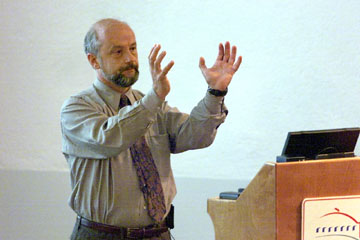 | Summer Lecture Series speakers, left to right: Pier Oddone, Carolyn Larabell, Gerson Goldhaber, Don DePaolo, and Gerald Rubin. (Pier Oddone, and Gerson Goldhaber, shown) |
|
Research Probe Raises Scientific Integrity Issues
By Ron Kolb
Recent national news reports about the scientific misconduct investigations of a former scientist at Berkeley Lab have focused the attention of the research community on the importance of scientific integrity and responsibility.
Since Science magazine first reported the investigation and subsequent scientific misconduct findings against Dr. Robert Liburdy in its July 2 issue, the Laboratory has been responding to public and media inquiries about the case. Although Berkeley Lab's own investigation is more than four years old, it was the published conclusions of the federal Office of Research Integrity (ORI), a branch of the Department of Health and Human Services, on June 17 that generated the interest.
In essence, the ORI validated the Laboratory's assessment that Liburdy, who was employed by the Laboratory for 15 years until he resigned last March, "engaged in scientific misconduct ... by intentionally falsifying and fabricating data and claims" on how electromagnetic fields (EMF) affect living cells. These data and claims were reported in two scientific papers published in 1992.
Liburdy's work was among the first to offer a plausible mechanism for a possible link between EMF exposure -- the kind shed by power lines and home appliances -- and calcium signaling, a fundamental cell process governing many important cellular functions. These results were interpreted to mean that there was a proven correlation between EMF and a number of cancers.
An agreement with ORI indicated that Liburdy was to retract certain figures in the two papers and not receive federal funds for three years, but also that he "neither admits nor denies ORI's findings of scientific misconduct."
Last week, the National Cancer Institute (a division of National Institutes of Health) asked the Lab and the University of California to repay $804,000 that it says was misspent as part of Liburdy's research in 1991-94. The Laboratory has said it will appeal the decision, indicating that the Lab's aggressive pursuit of the misconduct charges was responsible institutional behavior that should not be penalized through a financial assessment.
In light of the publicity that surrounded ORI's report, Life Sciences Division Director Mina Bissell issued a memo to her scientific staff, which cautioned, "We all have to be aware not to exercise prejudice in any area of science but rather to interpret and present data correctly."
She continued, "It is important to remind ourselves that scientists in every institution and at all levels need to police themselves. As you know, there have always been a few who have a tendency to exaggerate and misinterpret data, and at times even fake it (knowingly or unconsciously). I cannot stress enough that our high standards must be maintained. We all must be vigilant in our own research, but also in insuring that our colleagues are taken to task if the evidence warrants."
Some media reports misstated certain aspects of the Liburdy case. In one instance, it was suggested that a whistle-blower alerted the ORI to the issue and triggered the investigation. In fact, Berkeley Lab initiated its own probe back in 1994, alerted ORI in 1995, and submitted its conclusions to ORI in 1997. In a letter to the New York Times, Laboratory Director Charles Shank noted the Lab's perseverance in pursuing the matter and that "throughout, the guiding principle has been the integrity of the science, and I take full responsibility for pursuing it vigorously."
Another published error had to do with disposition of the unspent portion of the funding that supported Liburdy's research. As is routine practice, unused funds in such cases are not retained by the Laboratory but are returned to the federal government. This was reflected in a letter from Director Bissell to Liburdy in April of 1998, which stated, "The Laboratory will relinquish interest in any remaining grant or contract funds, and unexpended balances will be returned to your research sponsors."
The Integrity of Research Policy can be found in the Regulations and Procedures Manual on the web at http://www.lbl.gov/Workplace/RPM/R2.05.html#RTFToC48.
Washington Report
Richardson to Ask Clinton to Veto New Security Agency
E
nergy Secretary Bill Rich-ardson would recommend that President Clinton veto a proposal passed by a House-Senate conference to create a National Nuclear Security Administration. Under the proposal crafted by House Republicans, the agency would be semiautono-mous within the DOE. The Secretary supports the establishment of an under-secretary position to oversee nuclear weapons activities, but does not want this official to set policy.A spokesperson said Richardson will ask for a veto of the proposed legislation in its present form. The Secretary says the reorganization would reduce his authority and give too much authority to the new under-secretary.
Changing Faces on the National Lab Scene
Y
oon Chang, associate laboratory director for engineering research at Argonne National Laboratory, has assumed ANL's interim directorship. He replaces Frank Fradin, who has served as the Lab's interim director since August 1998, when Dean Eastman stepped down to return to teaching.At Oak Ridge National Laboratory, Director Alvin Trivelpiece, head of ORNL since 1989, has announced that he will step down next March.
Texan Is House Science Panel's New Ranking Democrat
Rep. Ralph Hall of Texas has replaced the late Rep. George Brown (D-Calif), who died last month, as the ranking Democrat on the House Science Committee. He will also continue to serve as ranking Democrat on the House Commerce Energy and Power Subcommittee.
DOE Issues Draft EIS on Yucca Mountain
T
he Department of Energy has released a draft environmental impact statement on the projected consequences of building a high-level nuclear waste repository at Yucca Mountain. The EIS also examines the projected consequences of not building the repository and allowing the waste to accumulate at existing DOE and commercial sites. The DOE will accept public comments on the statement starting today and until Feb. 9, 2000. It will also conduct 16 public hearings during the 180-day comment period, including nine in Nevada. The draft EIS is available on the Internet at http://www.ymp.gov or by calling DOE at (800)967-3477.-- Lynn Yarris
Martha Krebs Recognizes Lab Scientists, Management
| During a July 29 visit to Berkeley Lab, DOE Office of Science Director Martha Krebs toured the 88-Inch Cyclotron (right) and spoke with Ken Gregorich and Victor Ninov, who recently reported their team's detection of Elements 116 and 118. She also delivered a DOE Plaque of Appreciation (above) to Mike Chartock, Berkeley Lab's head for Planning and Communications, for his "outstanding innovation in supporting DOE's science programs and exemplary personal commitment to the overall science strategic planning process." Chartock coordinated the development of the recently published Office of Science Strategic Plan. Krebs visited the Laboratory to discuss DOE Field Office realignments and Office of Science goals with senior managers, as well as to engage in programmatic briefings. Photos by Roy Kaltschmidt |
|
Berkeley Lab Licenses Bio Probe to Start-Up Firm
By Lynn Yarris
A new type of biological probe developed by Berkeley Lab scientists has been commercially licensed by a start-up firm in Palo Alto. Last fall, Lab researchers announced they had found a way to use nanometer-sized crystals of semiconductors, such as cadmium selenide and cadmium sulfide, as highly effective fluorescent probes for labeling and measuring biological molecules. (See Currents, Oct. 10, 1998) Now, through the Lab's Technology Transfer Department, the technology has been exclusively licensed to the Quantum Dot Corporation for use in biological assays.
The firm, which started up expressly to develop and commercialize this technology, also has a non-exclusive license to manufacture semiconducting nanocrystals as molecular-scale LEDs (light-emitting diodes) and transistors.
As part of the licensing transaction, the University of California, through Berkeley Lab, has been issued shares in the Quantum Dot Corporation as part of the licensing fees.
"Taking equity is a win-win situation for the company and the Lab," says Tech Transfer's Viviana Wolinsky, who negotiated the deal. "It allows Quantum Dot to devote more of its initial capital to moving the technology forward, and gives Berkeley Lab the prospect of significant financial returns."
In addition to the licensing agreement with Berkeley Lab, the Quantum Dot Corporation also sought and licensed complimentary nanocrystal technology from MIT and the University of Melbourne.
Semiconductor nanocrystal fluorescent probes (dubbed "Qdotsreg." by the Quantum Dot Corporation) offer a distinct advantage over conventional dye-molecules in that they emit multiple colors of light, which means they can be used to label and measure several biological molecules simultaneously. The unique optical properties of these semiconductor nanocrystals also hint at the possibility of observing changes that take place in labeled biological systems, such as living cells, over a period of time.
Development of the original semiconductor nanocrystal fluorescent probe technology was led by Paul Alivisatos and Shimon Weiss. Alivi-satos is an expert in the production by chemical means of semiconductor nanocrystals, simple inorganic solids consisting of a hundred to a hundred thousand atoms. He holds a joint appointment as a senior staff scientist with Berkeley Lab's Materials Sciences Division (MSD) and as a professor of chemistry at UC Berkeley. Weiss, a staff scientist with MSD, is an authority on single molecule fluorescence and spectroscopy.
"The development of semiconductor nanocrystals for biological labeling gives biologists an entire new class of fluorescent probes for which no small organic molecule equivalent exists," said Weiss at the time the research was first announced."These nanocrystal probes can be complementary, and in some cases may be superior to existing fluorophores."
Fly Holds Clues to Human Genomes
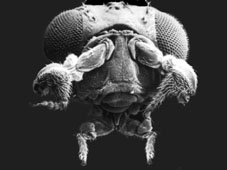 |
It may not look much like us (at least on our good-hair days), but the fruit
fly Drosophila melanogaster has chromosomes organized in a way similar to ours,
and has many genes whose functions hold clues to the function of genes in
humans. During his July 14 lecture, Gerald Rubin of Life Sciences, codirector
of the Berkeley Drosophila Genome Project, demonstrated that fruit flies learn
and remember, exhibit courting behavior, and can even become hooked on cocaine,
nicotine, and alcohol. Some fruit flies, in fact, are "cheap drunks," whose
genetic makeup predisposes them to pass out quickly in specially designed
inebriometers. Rubin and his colleagues study gene function in Drosophila melanogaster for a better understanding of its distant cousin, Homo Sapiens, including ways to prevent and control human diseases. |
Drilling Into a Plume of Fire
The Hawaiian Islands are the remnants of volcanoes that have moved over the biggest plume of hot rock on the planet. Unlike the more common volcanic activity produced by mid-ocean ridges or the subduction of continental crust, these islands are being formed by plumes thought to originate at the Earth's core-mantle boundary, some 3000 kilometers beneath the surface. As a volcano moves across the plume, the chemistry and other characteristics of the lava that feeds it change, giving scientists an insight into the region's geological history.
|
The Big Island itself is an agglomeration of five different volcanoes: those to the northwest, now extinct, those very active to the southeast, as well as a growing seamount, Loihi, still underwater offshore.
The drilling site sits near the Hilo airport, which DePaolo says is an excellent location for both scientific and practical reasons (including ease of getting a drilling permit, in a mere two-and-a-half years). Aside from an overlay from a 1,400-year-old Mauna Loa lava flow, the lava beneath the drill site is from Mauna Kea.
Islands grow as lava is first deposited faster than its accumulated weight pushes down on the ocean floor; but as lava production falls off, they sink again. The sea level constantly changes and can be tracked by the drilling project, which has encountered black sand beaches hundreds of meters down, and even coral reefs, previously thought not to form on the flanks of active volcanoes.
The lava flow process, DePaolo said, closely resembes that of a liquid heated from below, with every fraction of a second for the liquid corresponding to a few million years of geological upheaval.
As the project drills deeper it goes back in time: first sampling the last lavas deposited as Mauna Kea moved off the plume, then moving down to lavas from the center of the plume (differently composed and deposited faster and in greater volume), and next reaching lavas deposited as the volcano encountered the plume's leading edge. Finally, the borehole may even drill to the ocean crust.
DePaolo expects a wealth of new knowledge to be generated by this unique project over the next four or five year as the drilling moves down from the current depth of 7,289 feet -- at lecture time -- to an eventual target of 20,000 feet.
Lab Volunteers Bring Energy Efficiency to Community Home Improvement Effort
By Allan Chen
Every spring volunteers throughout the country assemble at the homes of low-income, disabled or elderly people to paint, make repairs, and otherwise renovate homes whose occupants don't have the means to maintain them themselves. Now, thanks to the efforts of a former postdoc from the Lab's Environmental Energy Technologies Division and a group of volunteers from EETD and the local community, the effort will now also be able to incorporate energy efficiency improvements into its activities.Called Christmas in April, the charity is a nationwide community service program operated by volunteers and supported by donations from corporations, businesses, civic organizations, foundations, neighborhood associations and individuals. In addition to fixing private homes, the organization also rehabilitates public and nonprofit facilities that serve the community.
Last April, a group of 27 volunteers, including a contingent from Berkeley Lab's EETD division, formed a special "energy team" for the Albany-Berkeley-Emeryville chapter's day of renovation. Held on April 24, the team was organized by Lisa Gartland, a former postdoctoral student and the current head of PositivEnergy, an Oakland-based consulting firm specializing in community energy conservation.
Gartland was initially hired to write a guidebook specifically for Christmas in April volunteers on how to make homes more energy-efficient. While working on the guidebook, she met with the director of the Albany-Berkeley-Emeryville chapter and attended "house captain" meetings.
"After interviewing a number of house captains of Christmas in April teams," she says, "I realized that these people are often too busy just organizing their volunteer teams and scoping out the repairs to give much thought to energy efficiency, even though many were enthusiastic about incorporating basic efficiency improvements into their plans."
Moreover, the cost of materials and equipment for implementing energy efficiency measures could be prohibitive for an organization that relies on donated materials. Even with a guidebook, energy efficiency improvements could easily get left at the door.
To show that making energy efficiency improvements could be a part of Christmas in April activities, Gartland volunteered to organize the energy efficiency team herself. She recruited 27 people, including nine of her colleagues at the Lab as well as friends and neighbors. She also raised 3,000 dollars' worth of materials and ran four training sessions for the volunteers. Donors included the City of Berkeley's Weatherization Program, the East Bay Municipal Utilities District, PostivEnergy, and RSA Corporation.
On April 24, efficiency team members visited 30 houses. They installed compact fluorescent lamps and water heater blankets, sealed pipes, weatherstripped doors and windows, replaced thermostats, and insulated heaters. They also caulked gaps around water pipes and behind electrical outlets and made houses more water-efficient by installing low-flow showerheads, water aerators and toilet flow reduction bags.
Said EETD's Rick Diamond after his volunteer stint, "The energy team is a great model for how other Christmas in April communities can include energy retrofits in their renovation activities. We will be working through Rebuild America to champion the energy work at the national level."
Rebuild America is a Department of Energy program that funds energy-efficient retrofits in local communities. EETD receives Rebuild America funding to provide energy-efficient design assistance to local communities performing efficiency retrofits.
Gartland estimated that implementation of these measures saved occupants about $60 per house per year, or a total of $420 per house over the life of the installed technologies.
In addition to finishing the energy efficiency guidebook, Gartland is developing a website for Christmas in April volunteers on how to organize energy efficiency teams in the hope that energy efficiency will become a routine part of future events nationwide. Next she plans to attend the annual Christmas in April conference in September in Saint Louis to discuss the energy efficiency team concept and to try to get energy efficiency team organized elsewhere in the United States.
For information on volunteering for Christmas in April, contact the organization at 644-8980. The energy efficiency guidebook, which includes pictures from the April event, is posted on the web at http://www.california.com/~positivenergy/xina.
 Lab and community volunteers formed a Christmas in April "Energy Team" for this spring's home improvement event. Left to right are Robin Mitchell, Smita Chandra, Paul and Karen Rosen, and Rich McClure. |
Millennium Laughs
Signs that you have had too much of the 90's- You tried to enter your password on the microwave.
- You haven't played solitaire with a real deck of cards in years.
- You have a list of 15 phone numbers to reach your family of three.
- You e-mail your son in his room to tell him that dinner is ready, and he e-mails you back "What's for dinner?"
- Your daughter sells Girl Scout cookies via her website.
- You check your blow dryer to see if it's Y2K compliant.
- You chat several times a day with a stranger from South Africa but haven't spoken to your next door neighbor yet this year.
- You didn't give your valentine a card this year but you posted one for your e-mail buddies.
- Your grandmother clogs up your e-mail inbox, asking you to send her JPEGs of your newborn to create a screen saver.
- You pull up in your own driveway and use your cell phone to see if anyone's home.
1 million microphones = 1 megaphone
1 million bicycles = 2 megacycles
2000 mockingbirds = two kilomockingbirds
52 cards = 1 decacards
1/2 lavatory = 1 demijohn
1 millionth of a fish = 1 microfiche
453 graham crackers = 1 pound cake
10 rations = 1 decoration
10 millipedes = 1 centipede
3-1/3 tridents = 1 decadent
10 monologues = 5 dialogues
2 monograms = 1 diagram
8 nickels = 2 paradigms
2 baby sitters = 1 gramma grampa
Compiled by Paul Preuss
Currents Online
P
ublished twice a month by the Public Information Department for the employees and retirees of Ernest Orlando Lawrence Berkeley National Laboratory. Ron Kolb, PID department head.
EDITOR: Monica Friedlander, (510) 495-2248, msfriedlander@lbl.gov
STAFF WRITERS: Paul Preuss, 486-6249; Lynn Yarris, 486-5375
CONTRIBUTING WRITERS: Jon Bashor, X5849; Allan Chen, X4210, Jeffery Kahn, X4019
FLEA MARKET / CALENDAR: Jacqueline Noble, 486-5771
fleamarket@lbl.gov /
currents_calendar@lbl.gov
Public Information Department, Berkeley Lab, MS 65A
One Cyclotron Road,
Berkeley CA 94720
Tel: 510/486-5771 Fax: 510/486-6641
Berkeley Lab is managed by the University of California for the U.S. Department of Energy.
The full text and photographs of each edition of Currents are published online at http://www.lbl.gov/Publications/Currents/. The site allows users to do searches of past articles going back to 1994.
Bulletin Board
Summer Fun with Science Exploration Camp
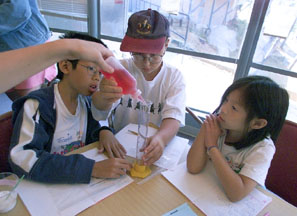 | 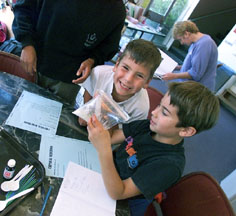 |
| Looks like chemistry can be lots of fun after all. Last month children of Lab employees got a hands-on feel for "Chemistry in the Kitchen" in the lower cafeteria during a session of the Summer Science Exploration Camp. The camp provides both recreational and science-oriented activities with weekly themes over the course of six weeks. The activities were held at Berkeley Lab, the Lawrence Hall of Science and the UC Botanical Gardens. | |
Bldg. 62 Cafeteria Services to End
On Aug. 20 the Facilities Department will discontinue its cafeteria services to Bldg. 62. Since opening in the building's lobby last September, the operation has continued to lose money, despite numerous efforts by the vendor, Eurest Dining Services, to build sales and cover operating costs.
Please direct any questions to Bob Berninzoni at X5576 or RABerninzoni@lbl.gov.
Hall of Science Seeks Volunteers
The Lawrence Hall of Science is accepting applications for weekend volunteers who wish to learn more about science and science education and help children and families enjoy science. A science background is not required -- only a desire to learn and serve and good people skills.
LHS "weekend docents" may select their assignments from among a variety of activities, such as special events for visitors, tours of exhibits, museum hosting, computer lab programs, planetarium shows (knowledge of astronomy required), and more.
For more information contact the Hall of Science at 643-5471.
Postdoc Society Holds Summer Picnic
The Berkeley Lab Postdoctoral Society will host a summer picinic on Sunday, Aug. 22, in Cordonices Park (1012 Euclid Avenue, Berkeley, fireplace #2). The event will start at 4:30 and continue through 8:30 p.m. Organizers have reserved an adjacent playing field, so bring along your friends, family and sports gear for an afternoon and evening of fun and games. Everyone is welcome. The cost is $5 and the main course is provided. No alcoholic beverages are permitted.
To participate please register by Thursday, Aug. 19 by contacting Karine Buriez (KBuriez@lbl.gov) or via the web (http://www.lbl.gov/~postdoc). For car pool information, visit the website above.
Employee Activities Association Seeks Nominations for Advisory Panel
Nominations are being accepted for two openings on the Employee Activities Association Advisory Panel. These three-year positions are open to all Lab employees. Openings are available for one Recreational Groups representative and one Cultural Groups representative. The responsibilities of the Advisory Panel are to advise management and the activities coordinator about association activities, monitor the distribution of funds, monitor activities, provide long-term planning, and recommend new programs and activities.
To place your name in nomination contact activities coordinator Kathy Gray by Sept. 3 (kjgray@lbl.gov, MS 90-1140, fax X7793). Make sure to indicate the openingposition you are interested in, and include a brief statement with information about yourself, why you are interested in serving on the panel, and a list of committees or panels on which you have served previously. Labwide elections will be held in September.
For more information see the EAA web page at http://www.lbl.gov/Workplace/HumanResources/EAA/.
International Tech Transfer Talk
Guest speaker Daniel Rouach, the co-author of several French books on technology transfer, will give a talk on Aug. 16 about technology transfer in Europe. He will also compare the practices there with those in the United States. Rouach has consulted on technology transfer and Management topics for corporate and state institutions around the world.
The presentation will be held from 3:00 to 4:00 p.m. in Bldg. 90-3148.
Courier Services
The Facilities Department is providing the Lab with rush courier service, with pick-up and delivery both on- and off-site. Transportation can deliver up to 2,000 pounds anywhere in the Bay Area or in central or northern California. Onsite materials will be delivered within one hour. For offsite service, a driver is available during normal business hours for same-day pick up and delivery. To request a pick-up, call Peggy Patterson at X5404.
Courier service (two-hour, four-hour, same day, and rush service) is also available from IDS Courier, which operates 24 hours a day and provides pick-up and delivery anywhere in the Bay Area and in portions of northern and central California. For information call Linda Wright at 548-3263.
Lab Life
Dana Conant, who worked in administrative support for the Computing Services Department in the late 1980s, was killed in a traffic accident in June. She was 45.
"Dana was very personable and talented," said colleague Carole Casaretto of Information Computing Sciences. "Even with her many duties she made time to teach computer graphic classes for the Workstation Group."
A graphic designer, Conant did much of the design and production for the Mt. Shasta Ski Park and organizations in her community. She is remembered fondly by her friends for her community involvement.
A memorial service was held on June 10. Donations in her name may be made to the Siskiyou Humane Society (5821 Dunsmuir Avenue, Dunsmuir, CA 96025) or to the Dana Contant Memorial Fund, a student scholarship program in her memory, to be made through Scott Valley Bank.
Calendar of Events
The Berkeley Lab Calendar is published biweekly here on the World Wide Web and in Currents by the Public Information Department. Employees can list a meeting, class, or event in the Calendar by using this submission form. The deadline for submissions is 5 p.m. on Monday in the week that Currents is published.
In addition to the events listed below, Berkeley Lab's Washington, D.C. Projects office is hosting a Science and Technology Seminars series.
Scientific Conferences
General Interest
MON, AUG. 16
TECHNOLOGY TRANSFER IN EUROPE: GUEST SPEAKER3:00 - 4:00., Bldg. 90-3148
THURS., AUG. 19
SHOEMOBILE7:30 - 3:30, cafeteria parking lot
SUN., AUG. 22
POSTDOCTORAL SOCIETY PICNIC CORDONICES PARK, BERKELEY4:40 - 8:30 p.m.
SAT., AUG. 28
MUSEUM TOUR, S.F.Treasury of St. Francis of Assisi Contact Mary Clary, X4940
Items for the calendars may be sent via e-mail to currents_calendar@lbl.gov,
faxed to X6641 or mailed to Bldg. 65B. The deadline for the Aug. 27 issue is 5
p.m. Monday,
Aug. 23.
Seminars & Lectures
WED., AUG. 18
APPLIED MATH SEMINAR"Handling Diffusion Effects in Particle Methods, Another Way: Diffusion Velocity Method" will be presented by Sylvie Mas-Gallic of Universite Evry-Val-d'Essonne and Ecole Polytechnique, France.
4:30 p.m., 50A-5132
FRI., AUG. 20
EARTH SCIENCES DIVISION SEMINAR"The Archeohydrology of Peru: The Fountain of Tambomachay" will be presented by Jerry Fairley of Earth Sciences.
11 a.m., Bldg. 90-2063
WED., AUG. 25
APPLIED MATH SEMINAR"Plastic Deformation and Fracture in Noncrystalline Solids" will be presented by James Langer of UC Santa Barbara.
4:30 p.m., 50A-5132
FRI., AUG. 27
JOINT CENTER FOR BEAM PHYSICS-NUCLEAR SCIENCE DIVISION SEMINAR"Status of the SPIRAL Project" will be presented by Bernard Laune of Institut de Physique Nucléaire (Orsay) and SPIRAL Group (GANIL, Caen)
10:30 a.m., Bldg. 71 conference room
MON., AUG. 30
PHYSICS DEPARTMENT COLLOQUIUM"Exploring our Local Galactic Environment with Pickup Ions" will be presented by George Gloecker of the University of Maryland.
4:30 p.m., 1 LeConte Hall, UC Berkeley
California Digital Library Enhances Access
N ew features -- including additional "clickable" paths to full online journal content -- have been added to the California Digital Library for access to UC's 315,000 scholars, students and staff. The CDL, which partners with the nine UC campuses, opened last January. Its main website and many of its resources (including digitized collections of photographs, manuscripts, and other archival materials from institutions around the state, are also available to the public.
The July release of the new features represents another step in UC President Richard C. Atkinson's vision of "a future when our libraries, at the press of a button, can come to us -- wherever we are, whenever we wish."
For more information visit the library website at http://www.cdlib.org/.
Center for Bioinformatics to Host International Conference
NERSC's Center for Bioinformatics and Computational Genomics is hosting the "Objects in Bioinformatics' 99" conference, to be held at the DoubleTree Hotel Gateway Place in San Jose on August 19, 20 and 21. The conference will focus on the role of object-oriented technology, reusable software components, design patterns, and distributed computing in bioinformatics and computational genomics. These and other topics will be addressed both from an academic and an industrial perspective.
More information on the conference is available on the web at http://cbcg.lbl.gov/ OiB99/index.html.
Softball Club Standings
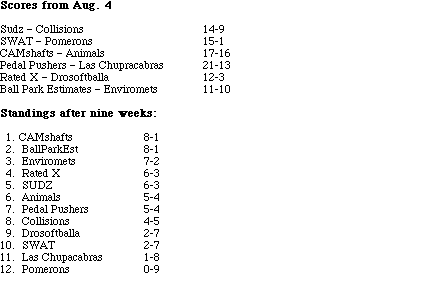
The league barbecue will be held on the last night of regular play, Aug. 18. Playoffs will be held on Aug. 25 and Sept. 1.
Flea Market
Autos / Supplies
`66 FORD Mustang, 289 and C-4 tranny, runs well, b.o.; 351W parts, heads, manifolds, carbs (Holley 4-barrel); many misc parts for classics, Scott, X7855`88 FORD Escort, 98K mi, auto, am/fm, just tuned up, good cond, runs well, $2,000, Olivier, X7055, 845-4851
`89 FORD Bronco 4x4, one owner, maint receipts, fresh smog and tune-up, runs fine, 5 spd/OD, pwr steer/brake/wndw/ lock, ac, am/fm/cass, $5,000, Tom, X8617, 430-1736
`91 MAZDA 626DX, 4 dr, blk, auto, ac, am/fm/cass, good cond, $3,850, Tennessee, 865-2553
`92 MAZDA 929, 4 dr, auto 4- spd, 84.5K mi, 6 cyl/3.0 L, abs, dual air bags, alarm, ac, leather, 6 CD changer, $7,900/b.o., Nancy, X4390
`93 MERCURY Tracer, 4 dr sedan, 76K mi, auto, ac, am/fm/ cass, new battery, reg maintained, 1 full yr warranty, just registered, $5,500, Eric, X7206
`96 BMW Z3, breathtaking dark blue convertible, soft blk top, immaculate leather int, cust wheels, am/fm/cass, perfect maint records, top of the line performance, $22,900/b.o., Claudia, (415) 499-6962
`96 MITSUBISHI Eclipse convertible, red/blk top, 38K mi, recently tuned, fun to drive, one owner, $16,000, Lily, 658-6615
`96 NISSAN, std cab truck, runs great, 38K mi, cd, shell, sliding window, tune-up, fluids, new shocks, very clean, $6,500, Ali, X7159, (925) 828-0560
TOOLS, Pulsar 465 elec ignitionanalyzer & Pulsar 180 inductive timing light, $75/b.o., Paul, 548-8548
Housing
BERKELEY, Elmood area, furn 1 bdrm, split-level, linen, dishes, HiFi, VCR, microwave, sunny, quiet, safe; walk to UC, hill view from large terrace, garage; prefer one mature, neat, nonsmoking visiting researcher, minimum 10 mo, $880/mo, leave name, phone number and e-mail, 843-6325BERKELEY HILLS studio, Campus Dr, 5-min walk to Lawrence Hall, separate entrance, deck, nice view, microwave, fridge, no kitchen, full bth, 2 nice-sized closets, $750/mo + deposit + 25% util, Ali, X7159, 845-4624
BERKELEY HILLS, modern studio apt in architect designed home on edge of Tilden Park, very quiet/private, own deck/entrance, free parking, dishwasher, full-sized fridge, lg bthrm, Murphy bed, security sys, close to Lab, bus #65, 1 person only, no smokers/pets, $900 + elec, avail Sept. 1, Evan, 486-6784
ELMWOOD, share elegant 11 rm house w/ 2 men, 1 woman, non-smoking professionals, $600/mo + dep, share exp, $745 for mstr bdrm w/ frplc and huge closet, some weeknight omnivorous dinners, piano, yellow Labrador, laundry, sauna, hardwood flrs, exc neighborhood, woman pref, Tony, 841-4480
OAKLAND, 1 bdrm apt, Lake Merritt/Children's Fairyland, close to BART, $630/mo + dep, includes 1 parking, avail Sept. 1, non-smoker, no pets, Jin, X7531, 452-1264
PINOLE, 1 bdrm/1 bth in house w/ working female, cats and sm dog, non smoker/drinker, full kitchen/laundry privileges, $600/mo, includes util and cable, possible carpool to Lab, avail 9/1, Sue, X6661, 758-4164
Miscellaneous
49er SEASON game tickets, 2 seats, sec 47-upper res (30 yard line), for all games this season incl preseason, $50 ea, Al, X5908, (925) 672-271649er TICKETS, sec 6/lower res, row 2/seats 18 & 19, $75 ea, cash only, Sheryl, X5126
BIKE TRAILER, holds two kids, folds up for storage, rarely used, $150/b.o. ($320 new), Steve, X5828, (925) 631-1448
COREL WORD PERFECT SUITE WP 6.1, Quattro 6.0 for Windows 3.1 (runs on 95), best offer, Steve, X6941
DARKROOM ENLARGER/equipment, $75; light table, $50; layout handwaxer, $15; assorted geotapes, $5; other graphics and art supplies, Vicki, 215-5708
DINING TABLE, oak w/ foldout leaves, surface imperfect, (4) oak chairs, newly reupholstered, $400/b.o., Steve, X6941
DISHES, stoneware by Wedgewood, "Midwinter" pattern, 12 each: dinner, salad, bread and butter, cups and saucers, cereal bowls; 3 serving pieces: platter, bowl, sauce server, dishwasher & microwave-safe, good cond, $50; various coord placemats, napkins, napkin rings, Harvard, 526-5347
FOLDING BICYCLE TRAILER, holds 2 kids, rarely used, $320 new, asking $150/b.o., Steve, X5828, (925) 631-1448
MOVING SALE, all prices are 50% off purchase price, all 1 yr old: futon/couch (full size), $80; coffee table, oak, 46"x23"x16", $40; mattress + boxspring, queen, $100/b.o.; desk lamp, $10; pole lamp/3 bulbs, $10; Lenka, 495-2208 (lab), 232-1477
MOVING SALE, 19" TV (RCA), $100; VCR (Philips), $70; microwave, $40; futon bed, $50; TV stand, $25; bookcase, $10; desk, $10; toddler bed, $25; vacuum cleaner, $30; 3 rm Greatland tent, $100; digital answering machine, $17; telephone (AT&T), $8; kitchenware, more, Thierry, X7498, 763-4469
MOVING SALE, all prices 50% or less of purchase price, 19" TV (Samsung)+antenna cables, $110; solid-pine bookcase, $20; wide table (28"x6'x30"), $15; solid wood table (29.5"x 37" x37"), $40; 4 wooden chairs, $10 ea or all for $30; adj foldable recliner chair, gray cloth, $10; chair, $20; mountain bike/chain lock, $40; vacuum cleaner, $30; Futon + wooden support, $30; other: message board, coffee maker, hand blender, bed-linen, pillows, iron board, thermos, cooking pots, a variety of glasses, mugs, bowls, wooden dough stretcher, etc; Erik, X4555, 528-0484
OPERA TICKETS, SF, 9/18 - Louise (Fleming/Ramey), 10/1 - Ballo In Maschera (Vaness), $l50/pair, balcony circle center, Diana, X6444
RADIO/TAPE/CD portable, Aiwa, like new, avail 8/31, $80, Olivier, X7055, 845-4851
SERVICE, interior painting, free estimate, Rita, X5621, 465-3813
STEAMER TRUNK, Titanic era, upright, $75; steel desk, $50; Casio keyboard, $40; piano accordion, $35, Stu, 525-2367, eve
TV STAND, Queen Anne style, cherry, Basset, $200/b.o.; Nordic Track Walkfit, $100/b.o., Michelle, X7073, 547-0792
Wanted
HARLEY DAVIDSON flathead 45" parts; Outlaw II style rims for Ford; body parts for 1953 - 55 Ford F100 (need a tail-gate bad!), Scott, X7855HOUSING for visiting professor and wife, arrive 10/15 from Israel for 1 year, 2 bdrm apt or house, prefer Berkeley, El Cerrito or Albany (hills), mpolak@bgumail.bgu.ac.il
HOUSING for visiting professor (German/Swiss), 1-2 bdrm, furn or not, dieter.suter@physik.uni-dortmund.de or Alex, 642-1220
HOUSING for postdoc, Physics Dept, arrive 9/1, studio or 1-bdrm apt, Berkeley, grojean@ spht.saclay.cea.fr
HOUSING in Berkeley, Kensington or Albany for assist to emeritus physicist, short term starting in Aug (or longer if mutually agreeable), prefer in-law unit w/ separate entrance, references, Senta, 524-4654
Carpool
SAN FRANCISCO (Haight, Noe Valley and Castro regions) to UCB and LBL, 8 am and 5 pm, needs extra rider, David, X6013VACAVILLE/FAIRFIELD (R/T) to LBL, Marcella, X6304
Lost & Found
FOUND: Pen knife, 2" long, dark wood and steel, found on 7/30 in the cafeteria, owner can claim at Bldg. 50-6016, Armin, X7184LOST: Reading glass w/ half lens, wire frames, last seen 8/2 on tool crib near 76 Plumbing Shop by rollup doors, Kathy, X5643
Flea Market Ad Policy
Ads are accepted only from LBNL employees, retirees, and on-site DOE personnel. Only items of your own personal property may be offered for sale.
Submissions must include name, affiliation, extension, and home telephone number.
Ads must be submitted in writing--via e-mail (fleamarket@lbl.gov), fax (X6641), or delivered/ mailed to Bldg. 65B. No ads will be taken by phone.
Ads will run one issue only unless resubmitted in writing. They will be repeated only as space permits.
The deadline for the Aug. 27 issue is 5 p.m. Friday, Aug. 21.
